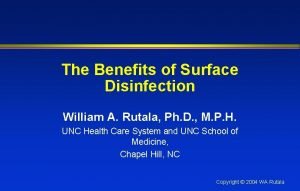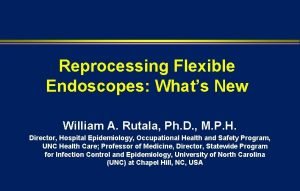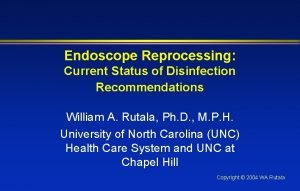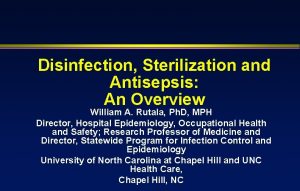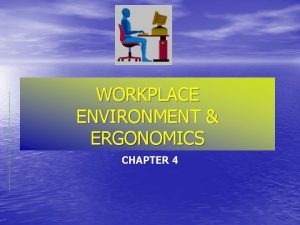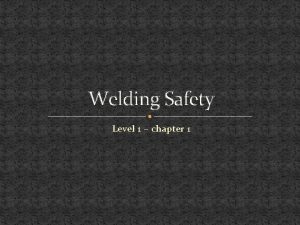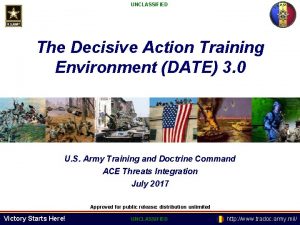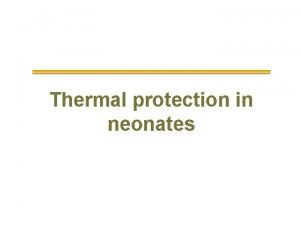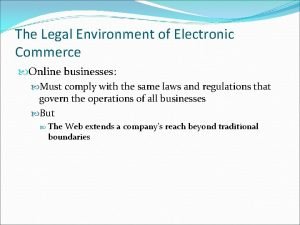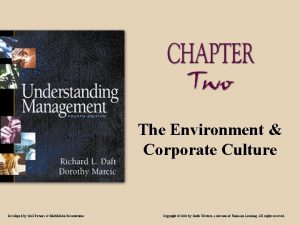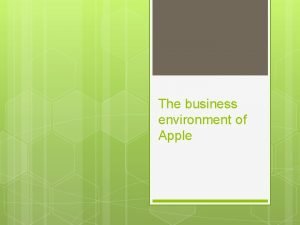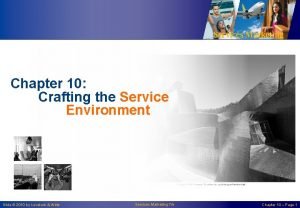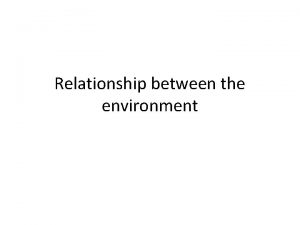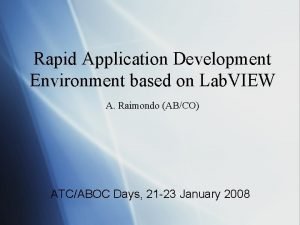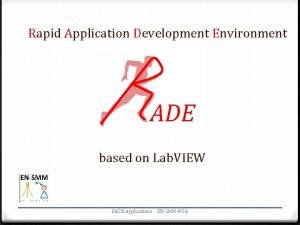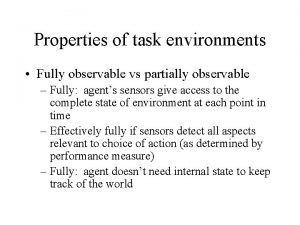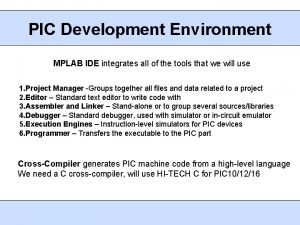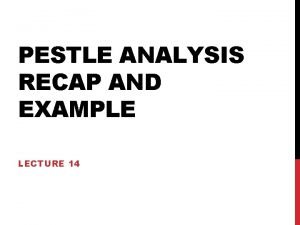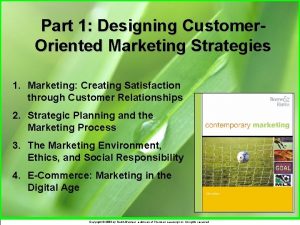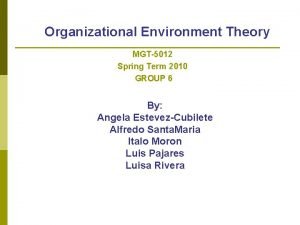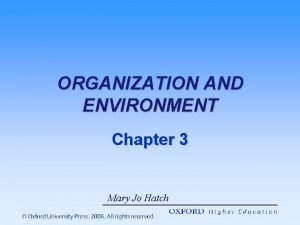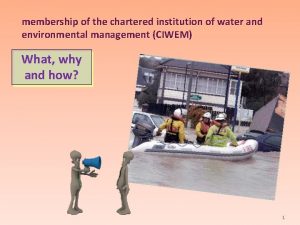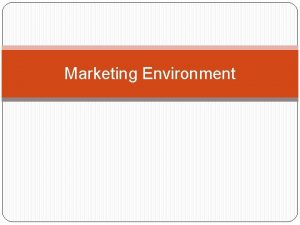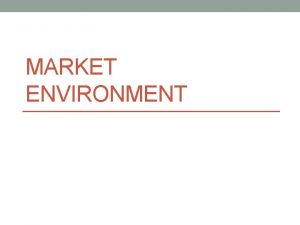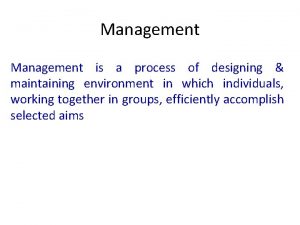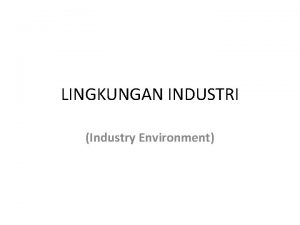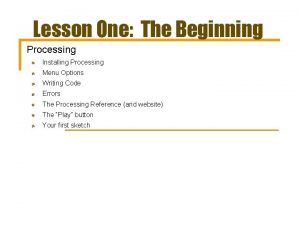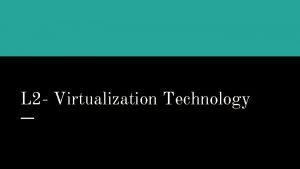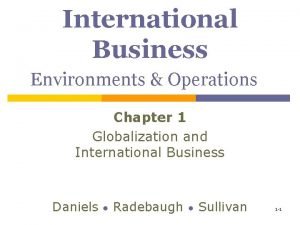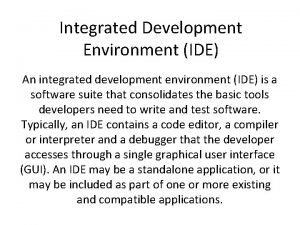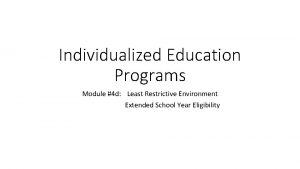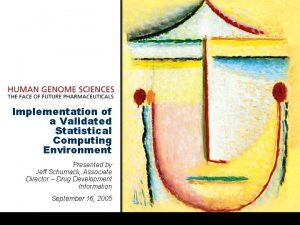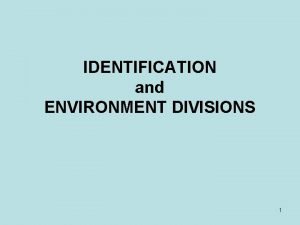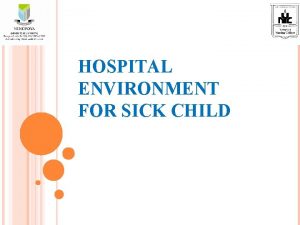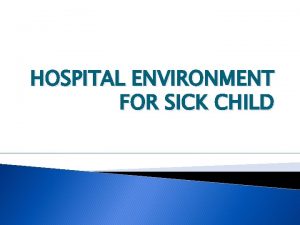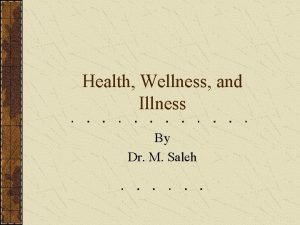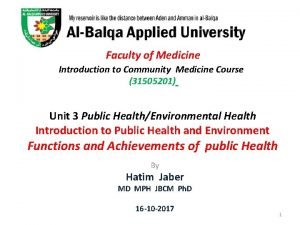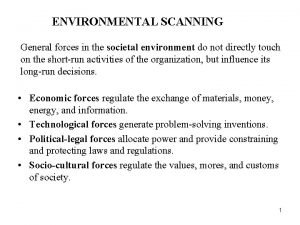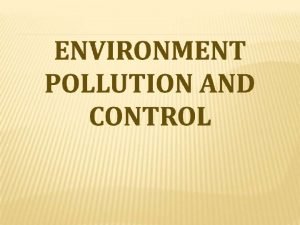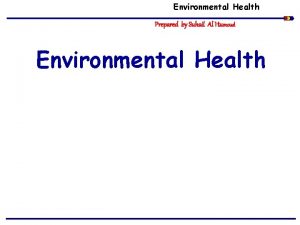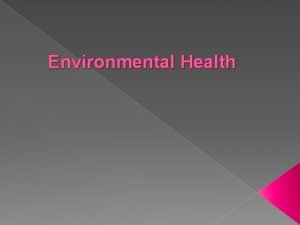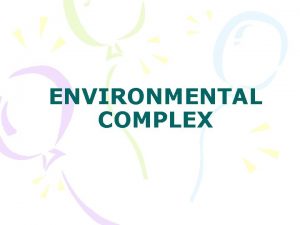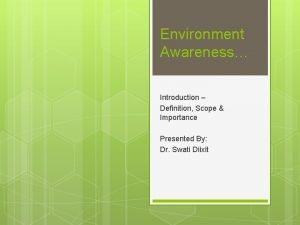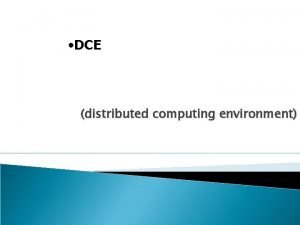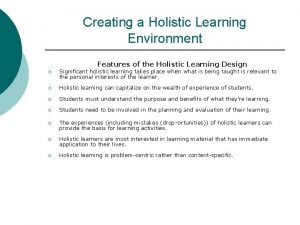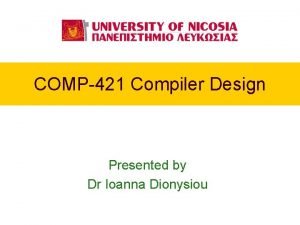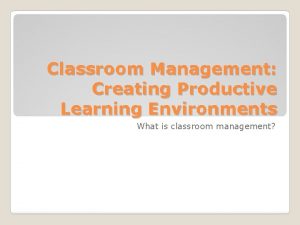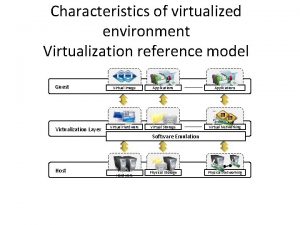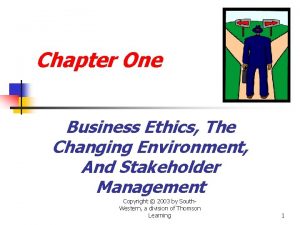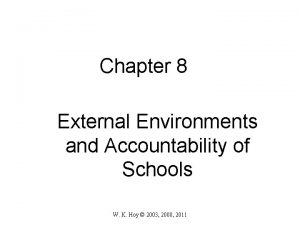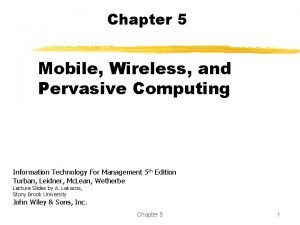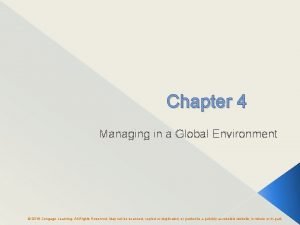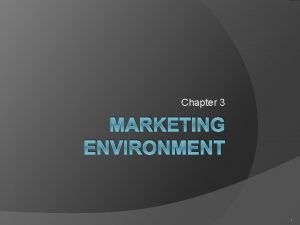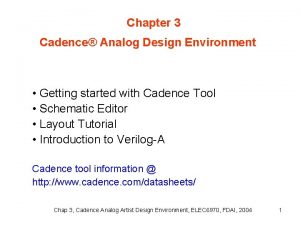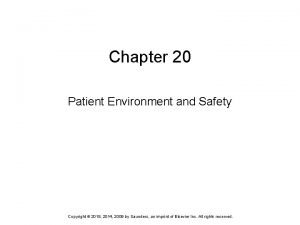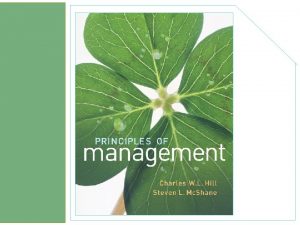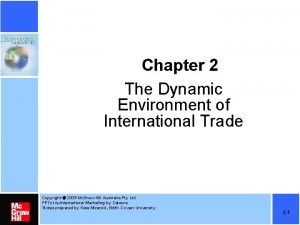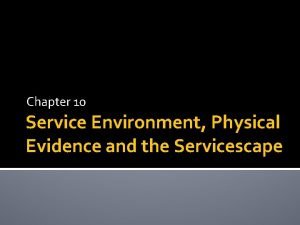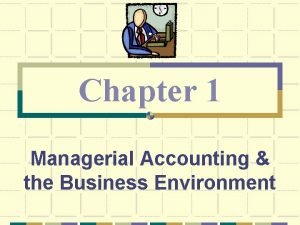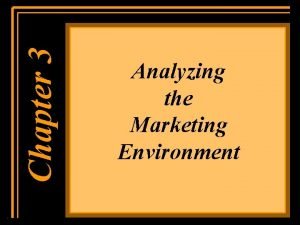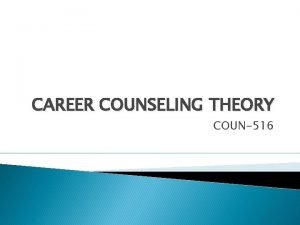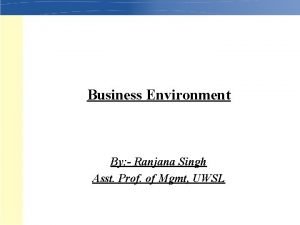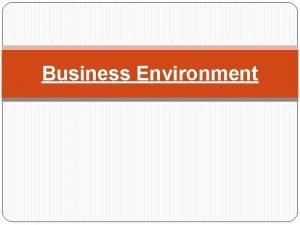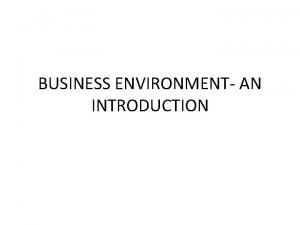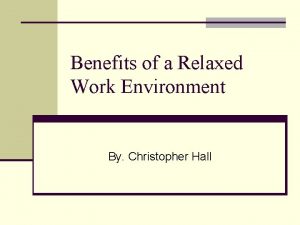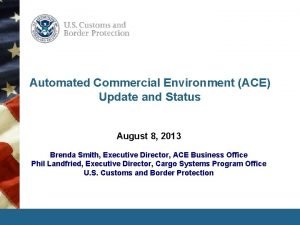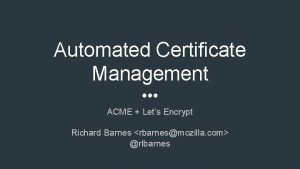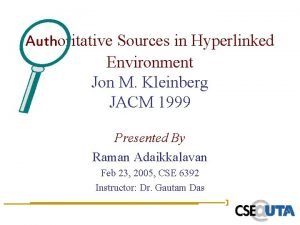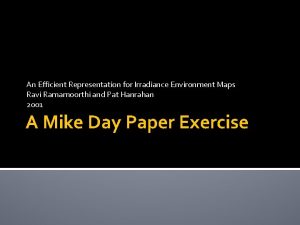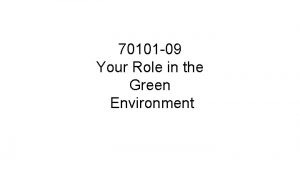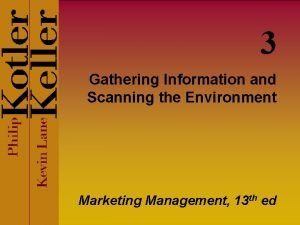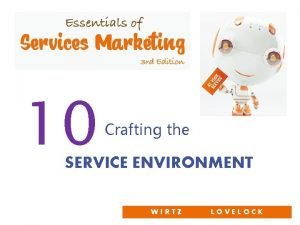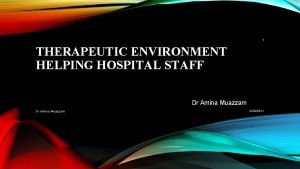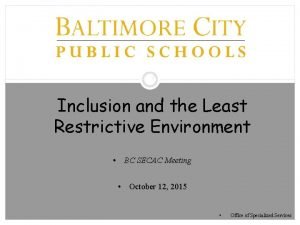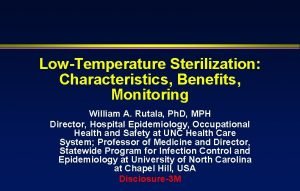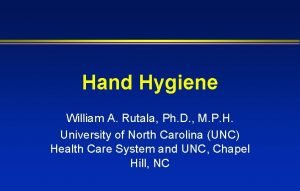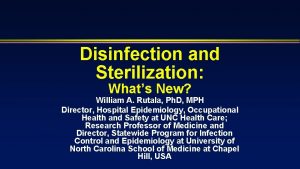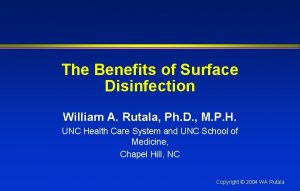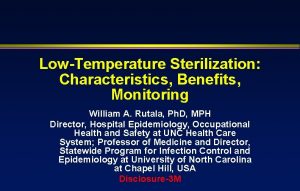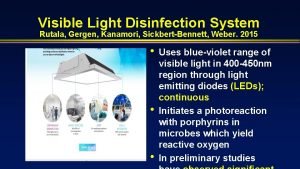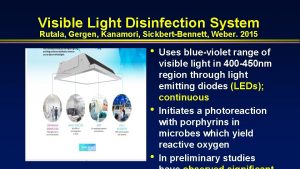Environment of Care William A Rutala Ph D














































































































































- Slides: 142

Environment of Care William A. Rutala, Ph. D. , M. P. H. , C. I. C. Director, Statewide Program for Infection Control and Epidemiology and Research Professor of Medicine, University of North Carolina at Chapel Hill, NC, USA Former Director, Hospital Epidemiology, Occupational Health and Safety, UNC Health Care, Chapel Hill, NC

Environment of Care l CBIC-14 questions. Will test knowledge of the following: n HVAC and construction n Water n Assess infection risks of design, construction and renovation n Evaluation and monitoring of environmental cleaning and disinfection practices n Evaluate environmental disinfection practices

Environment of Care l CBIC-14 questions. Will test knowledge of the following: n HVAC and construction n Water n Assess infection risks of design, construction and renovation n Evaluation and monitoring of environmental cleaning and disinfection practices n Evaluate environmental disinfection practices



Environmental Infection Control for Special Health Care Settings

SPECIAL HEALTHCARE SETTINGS (Airborne Infection Isolation-AII) l Planning new or renovating AII units Directed airflow: exhaust air to the outside, away from air-intake and populated areas (IC) n Well-sealed room (IB) n Room-air pressure: Maintain continuous negative room with respect to corridor; monitor air pressure periodically (IB). ; install self-closing doors (IC) n Room-air changes: Maintain at >12 per hour (IB) n

Environmental Infection Control for Special Health Care Settings

Environmental Infection Control for Special Health Care Settings



Minimum Efficiency Reporting Value

Minimum Efficiency Reporting Value MERV 14 for OR

Heating, Ventilation and Air Conditioning MERV 8 (30 -35% in 3 -10 u)

Heating, Ventilation and Air Conditioning MERV 11 (60 -65% in 1 -3 u)

Heating, Ventilation and Air Conditioning MERV 14 (90 -95% in 0. 3 -1 u)

Heating, Ventilation and Air Conditioning HEPA (High Efficiency Particulate Air)

Conditioning Activated Carbon Filter-removes organic compounds and odors

Heating, Ventilation and Air Conditioning Supply Air to Hospital Patient Rooms

Heating, Ventilation and Air Conditioning Exhaust Fans on Roof

Environment of Care l CBIC-14 questions. Will test knowledge of the following: n HVAC and construction (airborne fungal contaminants) n Water n Assess infection risks of design, construction and renovation n Evaluation and monitoring of environmental cleaning and disinfection practices n Evaluate environmental disinfection practices

AIRBORNE FUNGAL OUTBREAKS Requirements l Susceptible host l Reservoir l Source l Infecting dose inhaled (most dependent on concentration of fungi in the air)

MOST COMMON PATHOGENS ASSOCIATED WITH CONSTRUCTION OR RENOVATION OUTBREAKS l l Aspergillus spp. (by far most important) Zygomycetes Other fungi Miscellaneous

Review of Fungal Outbreaks Kanamori, Rutala, Sickbert-Bennett, Weber. CID. 2015; 61: 433

NOSOCOMIAL ASPERGILLOSIS IN OUTBREAK SETTINIGS Vonberg, Gastmeier. JHI 2006. 63: 245 l l l l 53 studies with 458 patients 356 patients (78%) were lower respiratory tract Aspergillus fumigatus (154) and A. flavus (101) Underlying disease-hemotologic malignancies 299 (65%) Overall fatality rate in these 299 patients (57. 6%) Construction or demolition probable/possible source 49%; virtually all outbreaks attributable to airborne source, usually construction Patients at risk should not be exposed to Aspergillus

Review of Fungal Outbreaks Kanamori, Rutala, Sickbert-Bennett, Weber. CID. 2015; 61: 433

Review of Fungal Outbreaks Kanamori, Rutala, Sickbert-Bennett, Weber. CID. 2015; 61: 433


8 cases of invasive fungal sinusitis (6 A. flavus, 1 A. fumigatus, 1 Rhizopus) and 5 deaths; release of fungal spores from soil reservoirs during construction; cultures of air and dust during the construction period grew Aspergillus. Lueg et al. 1996


Aspergillus l l l Aspergillus spores are ubiquitous (soil, fruits, vegetables, dust, decaying organic matter) in the environment Conidia may travel long distances as airborne particles and are inhaled by humans (several hundred spores each day) In most healthy persons, spores are removed by innate defense mechanisms (macrophages) Severely immunocompromised (IC) hosts (hematologic, solid organ transplant) a serious complication Air is normally the route of fungal spore transmission

Medically-Important Mycotic Agents Aspergillus fumigatus

AIRBORNE FUNGAL OUTBREAKS

AIRBORNE FUNGAL OUTBREAKS l l Shown to increase the amount of airborne fungal spores dramatically (and in consequence increases the risk of Aspergillus infection in susceptible patients) n Internal renovation/construction/excavationconstruction is a never-ending phenomenon n Ceiling access n Contaminated or defective air supply Minimal airborne concentration of Aspergillus necessary to cause infection in IC patients remains unknown





CONSTRUCTION OR RENOVATION 1 l l l When planning construction, demolition, and renovation activities in and around the facility, assess whether patients at high-risk for aspergillosis are likely to be exposed to high ambient-air spore counts of Aspergillus spp. , and if so develop a plan to prevent such exposure {l. A} During construction, demolition, or renovation activities construct impermeable barriers between patient-care and construction areas to prevent dust from entering the patient-care areas {l. B] Direct pedestrian traffic that come from construction areas away from patient-care areas to limit the closing of or health-care-associated other barriers that 1 opening Tablan OC, and et al. Guidelines for doors preventing pneumonia, 2003 might cause dust dispersion {l. B}

CONSTRUCTION OR RENOVATION 1 l l Establish a multidisciplinary team that includes infection -control staff to coordinate demolition, construction and renovation {l. B, l. C} Educate construction and healthcare staff in immunocompromised patient-care areas regarding airborne infection risks associated with construction and preventive measures {l. B} Incorporate mandatory adherence agreements for infection control into construction contracts {l. C} Establish and maintain surveillance for airborne 1 Guideline for environmental diseaseinfection (e. g. , control aspergillosis) in health-careas facilities, 2003 appropriate during construction {l. B}

CONSTRUCTION OR RENOVATION 1 l Implement infection-control measures during construction, renovation, maintenance, demolition, and repair {l. B, l. C} n Before the project gets underway, perform an ICRA to define the scope of the project and need for barrier measures {l. B, l. C} u n Determine if immunocompromised patients may be at risk for exposure and develop a contingency plan to prevent exposures Implement infection-control measures for external demolition and construction {l. B} u Determine if facility can operate on recirculated air; if feasible, seal off adjacent air intakes 1 Guideline for environmental infection control in health-care u If not feasible, check and replace low-efficiency filters facilities, 2003 as needed

CONSTRUCTION OR RENOVATION 1 l Implement infection-control measures during construction, renovation, maintenance, demolition, and repair {l. B, l. C} n Implement infection-control measure for internal construction {l. B, IC} u Construct barriers to prevent dust from entering patient- care areas u Block and seal off return air vents (if needed) u Implement dust control measures; divert pedestrian traffic u Relocate patients adjacent to work zone (depending on their immune status) 1 Guideline for environmental infection control in health-care facilities, 2003

CONSTRUCTION OR RENOVATION 1 l Implement infection-control measures during construction, renovation, maintenance, demolition, and repair {l. B, l. C} n Perform engineering and work-site related infection control measures as needed for internal construction and renovations u Ensure properation of the air-handling system u Create and maintain negative pressure in work zones. CBIC u Monitor negative air flow inside of rigid barriers u Monitor barriers; repair gaps and breaks in barriers u Direct pedestrian traffic away from work zones u Provide designated travel routes for construction crew 1 Guideline for environmental infection control in health-care facilities, 2003 u Clean work zones daily u Clean and replace air filters

CONSTRUCTION OR RENOVATION 1 l l No recommendation is offered on routine microbiologic air sampling, before, during, or after construction {unresolved} If a case of healthcare-acquired aspergillus airborne fungal infection occurs during construction, implement appropriate measures {l. B} If there is epidemiologic evidence of ongoing transmission of fungal disease, conduct an environmental assessment to determine and eliminate the source {l. B} If air-supply systems to high-risk areas are not optimal use portable, industrial-grade HEPA filters on

INFECTION CONTROL RISK ASSESSMENT (ICRA) l ICRA is an multidisciplinary, organizational, documented process that after considering the facility’s patient population and type of construction project (non-invasive to major demolition): Focuses on reduction of risk from infection n Acts through phases of facility planning, design, construction, renovation, facility maintenance and n Coordinates and weights knowledge about infection, infectious agents, type of construction project and care environment permitting the organization to anticipate potential impact n

STEP 1: IDENTIFY TYPE OF CONSTRUCTION PROJECT http: //www. premierinc. com/quality-safety/tools-services/safety/topics/construction/downloads/ICRAMatrix. Color. Revised-091109. pdf

STEP 1: IDENTIFY TYPE OF CONSTRUCTION PROJECT

STEP 2: IDENTIFY PATIENT RISK

STEP 3: MATCH RISK GROUP WITH CONSTRUCTION TYPE

INFECTION CONTROL BY CLASS

INFECTION CONTROL BY CLASS During construction After

INFECTION CONTROL BY CLASS During construction After construction



OTHER STEPS 1. 2. 3. 4. 5. 6. 7. 8. 9. Identify areas surrounding the project area, assess impact Identify the specific sites of activity (e. g. , patient rooms) Identify issues related to: ventilation, plumbing, electrical in terms of possible outages Identify containment measures using prior risk assessment Consider possible water damage Work hours: Can work be done during non-patient care hours? Develop plans for the proper handwashing sinks Develop plans for use of clean and soiled utility rooms Communicate with project team: traffic flow, housekeeping, debris removal

SUMMARY l l l Outbreaks of aspergillosis and other fungi continue to occur in US healthcare facilities Highly immunocompromised patients are at highest risk Most are related to construction and renovation Appropriate implementation of CDC/HICPAC guidelines can prevent healthcare-associated infection Use of ICRA is a logical method to plan for

SURVEILLANCE 1 l l Maintain a high index of suspicion for healthcareassociated pulmonary aspergillosis in severely immunocompromised patients (ANC <500/mm 3 for 2 weeks or <100/mm 3 for 1 week)(l. A) Surveillance cultures Do NOT perform routine, periodic cultures of nasopharynx (l. B) n Do NOT perform routine, periodic cultures of equipment or devices used for respiratory therapy, PFTs, or dust in rooms of HSCT recipients (l. B) n NO recommendation for routine microbiologic air sampling before, during, or after facility construction or renovation (Unresolved) n l Perform routine surveillance of the ventilation status of 1 al. Guidelines for preventing health-care-associated pneumonia, 2003 PEs: Tablan room. OC, airet exchanges, pressure relations, filtration

PREVENTION l Well designed and maintained ventilation system n Appropriate placement of intake ducts n Filter all hospital air (90 -95% efficient filters) n Maintain filter integrity n Maintain appropriate pressure relationships n Proper maintenance of fans and filters l Review all construction and renovation activities

PREVENTION l Procedures during construction and renovations n n n Seal hospital construction areas behind impervious barriers Clean construction area daily (i. e. , remove dust) Assure that ventilation system does not transport dust from inside construction area to other locations Move immunocompromised patients from adjacent areas Thoroughly clean construction area prior to patient

AIR-HANDLING SYSTEMS IN HCF Ensure HVAC filters are properly installed and maintained (IB) l Monitor areas with special ventilation (AII, PE) for ACH and pressure differentials (IB) l Inspect filters periodically (IC) l Ensure intakes (>6 ft above ground) and exhaust outlets (>25 ft from intake) are located properly (IC) l

Heating, Ventilation and Air Conditioning Filter Bank of MERV 8

AIR-HANDLING SYSTEMS IN HCF Do not use through-the-wall ventilation units (air induction ventilation) for PE (IC) l Seal windows with centralized HVAC, especially PE areas (IB, IC) l Do not shut down HVAC for other than required maintenance, filter changes, and construction (IB, IC); coordinate to allow relocation of IC (IC) l Keep emergency doors and exits in PE l

Windows Closed

CONSTRUCTION, RENOVATION, REPAIR Establish a multi-disciplinary team to coordinate construction (IB, IC) l Educate both the construction team and healthcare staff in IC patient-care areas about the airborne infection risk (IB) l Incorporate mandatory adherence agreements for infection control into construction contracts (IC) l

CONSTRUCTION, RENOVATION, REPAIR l l Using active surveillance, monitor for airborne infections in IC patients (IB) Implement infection control measures: define the need for barriers (IB), ensure properation of the HVAC system (IB), implement dust control measures (IB), relocate IC patients as needed (IB), clean work zones daily (IB), create negative pressure in work areas relative to adjacent patient-care areas (IB), provide crews with designated entrances, corridors, elevators (IB)

SPECIAL HEALTHCARE SETTINGS High Risk Patients (PE, Solid Organ Transplants, Neutropenic) l Planning new units for high-risk patients n n n Air-filtration: Install HEPA filters (99. 97% efficient in filtering 0. 3µ-sized particles) either centrally or point of use (IB) Directed airflow: Place air-intake and exhaust ports so that room air flows across patient’s bed and exits on opposite side of the room (IC) Well-sealed room (IB) Room-air pressure: Maintain room at positive pressure with respect to corridor (IB) Room-air changes: Maintain at >12 per hour (IC)

SPECIAL HEALTHCARE SETTINGS High Risk Patients (PE, Solid Organ Transplants, Neutropenic) l l Do not routinely use laminar airflow (100 -400 ACH) in PE (II). Minimize exposure of high-risk patients to activities that might cause aerosolization of fungal spores (eg, vacuuming, disruption of ceiling tiles) (IB) Patients leave their room, provide respiratory protection (eg, N 95, surgical mask) (II) Minimize time the IC patients are outside their rooms for diagnostic procedures and other activities (IB)

SPECIAL HEALTHCARE SETTINGS (Airborne Infection Isolation-AII) l Planning new or renovating AII units n n n Directed airflow: exhaust air to the outside, away from air-intake and populated areas (IC) Well-sealed room (IB) Room-air pressure: Maintain continuous negative room with respect to corridor; monitor air pressure periodically (IB). ; install self-closing doors (IC) Room-air changes: Maintain at >12 per hour (IB) Ante room and audible alarm not required (12 AC/hr, negative airflow-CBIC)

SPECIAL HEALTHCARE SETTINGS (Operating Rooms) l Infection control measures for operating rooms Room-air pressure: Maintain positive-pressure ventilation with respect to corridors and adjacent areas (IC) n Room-air changes: Maintain at >15 per hour (IC) with at least 3 ACH of fresh air (20 AC/hr per FGI) n Directed Airflow: Introduce air at the ceiling and exhaust air near the floor (IC) n Doors: Keep room doors closed except for essential personnel, patients, equipment; limit entry to essential personnel (IB) n


SPECIAL HEALTHCARE SETTINGS (TB in Operating Rooms) If possible, last case of the day to allow for maximum removal of air contaminates (II) l OR personnel should use N 95 respirators (IC) l Intubate in the OR or AII (IB); extubate in AII (IB); keep OR door closed after intubation until 99. 9% air contaminants are removed (IC) l Use portable HEPA if the ACH does not l

Portable HEPA Units Rutala et al. ICHE 1995; 16: 391 Can rapidly reduce levels of airborne particles (0. 3µ, for example, 90% in ~5 m); used in construction worksite and reduce risk to TB exposure.

SUMMARY n Airborne fungal infections cause significant morbidity and mortality for immunocompromised patients n Despite understanding of the usual sources and reservoirs of these pathogens outbreaks continue to occur n Well-designed and maintained ventilation systems and use of proper infection control techniques during construction will prevent most fungal outbreaks

SUMMARY Surveillance is key to early detection of outbreaks l In the event of an outbreak careful evaluation of cases and an environmental evaluation will usually uncover a correctable cause l New tools of molecular epidemiology may prove useful to link specific reservoirs with outbreaks l

Environment of Care l CBIC-14 questions. Will test knowledge of the following: n HVAC and construction n Water n Assess infection risks of design, construction and renovation n Evaluation and monitoring of environmental cleaning and disinfection practices n Evaluate environmental disinfection practices

Water As A Source of Nosocomial Outbreaks CDC

WATER AS A SOURCE OF NOSOCOMIAL OUTBREAKS

WATER RESERVOIRS Rutala, Weber. ICHE 1997; 18: 609

Healthcare Outbreaks Associated with Water Reservoir Kanamori, Weber, Rutala. Clin Infect Dis 2016; 62: 1423

Healthcare Outbreaks Associated with Water Reservoir Kanamori, Weber, Rutala. Clin Infect Dis 2016; 62: 1423

Healthcare Outbreaks Associated with Water Reservoir Kanamori, Weber, Rutala. Clin Infect Dis 2016; 62: 1423

Healthcare Outbreaks Associated with Water Reservoir Kanamori, Weber, Rutala. Clin Infect Dis 2016; 62: 1423

WATER RESERVOIRS Potable water l Sinks l Faucet aerators l Showers l Tub immersion l Toilets l Dialysis water l Ice and ice machines l Water baths l Flowers l Eye wash stations l


LEGIONELLA: EPIDEMIOLOGY l l 10, 000 - 40, 000 cases/yr (1 -5% of adult pneumonia) Reservoir: Ubiquitous in aquatic environments Associated with devices that produce potable or non-potable water aerosols (e. g. , cooling towers, evaporative condensers, showers, faucets, decorative water fountains, whirlpool baths, ice machines, medication nebulizers, nasogastric feedings diluted in tap water) Transmission: Inhalation of aerosols (no

CONTROLLING WATERBORNE MICROORGANISMS l Water Systems in HCF n Hot water temp at the outlet at the highest temp allowable, preferable >124 o. F (IC)CBIC n When state regulations do not allow hot water temp >120 o. F, chlorinate the water or periodically increase >150 o. F (II) n Water disruptions: post signs and do not drink tap water (IB, IC)

LEGIONELLA What’s in your water?

LEGIONELLA: CONTROL MEASURES l l l Establish surveillance system to detect Legionnaires disease (IB); provide clinicians with lab tests (e. g. , urine antigen, DFA, culture) No recommendation on culturing water in HCF that do not have patients at high-risk for Legionella (transplant)(unresolved issue) One laboratory-confirmed case of Legionella, or two cases suspected in 6 mo in facility that does not treat IC patients, conduct epidemiological investigation (IB).

LEGIONELLA: CONTROL MEASURES l l One case in IC patient, conduct a combined epidemiological and environmental investigation (IB) If evidence of HA transmission, conduct environmental investigation to determine source: collect water samples from potential source of aerosolized water and subtype isolates of Legionella from patients and environment (IB) If source identified, institute water system decontamination (IB) and assess the efficacy of implementing control measures (IB) Culturing for Legionella in water from transplant

LEGIONELLA: CONTROL MEASURES l If Legionella spp are detected in water of a transplant unit, do the following: n Decontaminate the water supply (IB) n Restrict immunocompromised patients from showers (IB) n Use non-contaminated water for sponge baths (IB) n Provide sterile water for drinking, tooth brushing (IB) n Do not use water from faucets in patient

DIALYSIS WATER Excessive levels of gram-negative bacilli in the dialysate have been responsible for pyrogenic reactions in patients l Hazard caused by bacteria or endotoxin gaining entrance into the blood from the dialysate l

DIALYSIS WATER Control Measures l Sample dialysis water (input) monthly (IA) n Maintain l water <200 bacteria/m. L* Sample dialysate (output) monthly (IA) n Maintain water <2, 000 bacteria/m. L Perform endotoxin testing (IA) l Disinfect water distribution system on a regular basis (monthly recommended) (IA) *AAMI (2014) has a lower water quality standard for dialysis water l

Water Wall Fountains and Electronic Faucets

Water Walls Linked to Legionnaires’ l Palmore et al. ICHE 2009; 30: 764 n 2 immunocompromised patients exposed to decorative fountain in radiation oncology; isolates from patients and fountain identical; disinfection with ozone, filter and weekly cleaning l Houpt et al. ICHE 2012; 33: 185 n Lab-confirmed Legionnaires disease was dx in 8 patients; 6 had exposure to decorative fountain (near main entrance to hospital); high counts of Legionella pneumophila 1 despite disinfection and maintenance

Water Walls and Decorative Water Fountains Present unacceptable risk in hospitals serving immunocompromised patients (even with standard maintenance and sanitizing methods). CBIC-water not stagnant, prevent aerosolization, routine maintenance

Environment of Care l CBIC-14 questions. Will test knowledge of the following: n HVAC and construction n Water n Assess infection risks of design, construction and renovation n Evaluation and monitoring of environmental cleaning and disinfection practices n Evaluate environmental disinfection practices

Noncritical Medical Devices Rutala et al. AJIC 2016; 44: e 1; Rutala, Weber. Env Issues NI, Farber 1987 • • Contact: intact skin (noncritical medical devices, surfaces) Transmission: secondary transmission by contaminating hands/gloves via contact with the environment and transfer to patient Control measures: hand hygiene and low-level disinfection Noncritical devices

Environmental Contamination Leads to HAIs Weber, Kanamori, Rutala. Curr Op Infect Dis 2016: 29: 424 -431 § § § Evidence environment contributes Role-MRSA, VRE, C. difficile Surfaces are contaminated~25% EIP survive days, weeks, months Contact with surfaces results in hand contamination Disinfection reduces

by Patient C/I with Epidemiologically Important Pathogen Weber, Kanamori, Rutala. Curr Op Infect Dis 2016: 29: 424 -431 • • Results in the newly admitted patient having an increased risk of acquiring that pathogen by 39353% For example, increased risk for C. difficile is 235% (11. 0% vs 4. 6%)


Effective Surface Decontamination Product and Practice = Perfection

PROPERTIES OF AN IDEAL DISINFECTANT Rutala, Weber. Infect Control Hosp Epidemiol. 2014; 35: 855 -865 l l l Broad spectrum-wide antimicrobial spectrum Fast acting-should produce a rapid kill Remains Wet-meet listed kill/contact times with a single application Not affected by environmental factors-active in the presence of organic matter Nontoxic-not irritating to user Surface compatibility-should not corrode instruments and metallic surfaces Persistence-should have sustained antimicrobial activity Easy to use Acceptable odor Economical-cost should not be prohibitively high Soluble (in water) and stable (in concentrate and use dilution) Cleaner (good cleaning properties) and nonflammable

the Ideal Disinfectant for Your Facility Rutala, Weber. Infect Control Hosp Epidemiol. 2014; 35: 855 -865 Consideration Question to Ask Kill Claims Does the product kill the most prevalent healthcare pathogens Kill Times and Wet. Contact Times How quickly does the product kill the prevalent healthcare pathogens. Ideally, contact time greater than or equal to the kill claim. Safety Does the product have an acceptable toxicity rating, flammability rating Ease-of-Use Odor acceptable, shelf-life, in convenient forms (wipes, spray), water soluble, works in organic matter, one-step (cleans/disinfects) Other factors Supplier offers comprehensive training/education, 24 -7 customer support, overall cost acceptable (product capabilities, cost per compliant use, help standardize disinfectants in facility Score (1 -10) Note: Consider the 5 components shown, give each product a score (1 is worst and 10 is best) in each of the 5 categories, and select the product with the highest score as the optimal choice (maximum score is 50).

EQUIPMENT AND SURFACES (EPA-Registered. CBIC) Rutala, Weber. Infect Control Hosp Epidemiol. 2014; 35: 855 -865 Exposure time > 1 min Germicide Use Concentration Ethyl or isopropyl alcohol 70 -90% Chlorine 100 ppm (1: 500 dilution) Phenolic UD Iodophor UD Quaternary ammonium (QUAT) UD QUAT with alcohol RTU Improved hydrogen peroxide (HP) 0. 5%, 1. 4% Peracetic acid with HP (C. difficile) UD __________________________ UD=Manufacturer’s recommended use dilution; others in development/testing-electrolyzed water; polymeric guanidine; cold-air atmospheric pressure plasma (Boyce Antimicrob Res IC 2016. 5: 10) Cleaning solution container must be labeled with the chemical content, name and expiration date. No “topping off”. CBIC

Microbiological Disinfectant Hierarchy Rutala WA, Weber DJ, HICPAC. www. cdc. gov Most Resistant Spores (C. difficile) Mycobacteria (M. tuberculosis) Non-Enveloped Viruses (norovirus, HAV, polio) LLD Fungi (Candida, Trichophyton) Bacteria (MRSA, VRE, Acinetobacter) Most Susceptible Enveloped Viruses (HIV, HSV, Flu)

MOST PREVALENT PATHOGENS CAUSING HAI Rutala, Weber. Infect Control Hosp Epidemiol. 2014; 35: 855 -865; Weiner et al ICHE 2016; 37: 1288 l Most prevent pathogens causing HAI (easy to kill) n n n n n E. coli (15. 4%) S. aureus (11. 8%) Klebsiella (7. 7%) Coag neg Staph (7. 7%) E. faecalis (7. 4%) P. aeruginosa (7. 3%) C. albicans (6. 7%) Enterobacter sp. (4. 2%) E. faecium (3. 7%) l Common causes of outbreaks and ward closures (relatively hard to kill) C. difficile spores n Norovirus n Rotavirus n Adenovirus n

DISINFECTANTS AGAINST MRSA AND VRE Rutala WA, et al. Infect Control Hosp Epidemiol 2000; 21: 33 -38 .

Disinfection of Noncritical Surfaces Bundle NL Havill AJIC 2013; 41: S 26 -30 Develop policies and procedures l Select cleaning and disinfecting products l Educate staff to environmental services and nursing l Monitor compliance (thoroughness of cleaning, product use) and feedback l Implement “no touch” room decontamination technology and monitor compliance l

Blood Pressure Cuff Non-Critical Patient Care Item

Surface Disinfection Noncritical Patient Care Rutala, Weber, HICPAC. CDC 2008. www. cdc. gov l Disinfecting Noncritical Patient-Care Items n Process noncritical patient-care equipment with a EPA-registered disinfectant at the proper use dilution and a contact time of at least 1 min. Category IB n Ensure that the frequency for disinfecting noncritical patient-care surfaces be done minimally when visibly soiled and on a regular basis (such as after each patient


Surface Disinfection Environmental Surfaces Rutala, Weber, HICPAC. CDC 2008. www. cdc. gov l Disinfecting Environmental Surfaces in HCF n Disinfect (or clean) housekeeping surfaces (e. g. , floors, tabletops) on a regular basis (e. g. , daily, three times per week), when spills occur, and when these surfaces are visibly soiled. Category IB n Use disinfectant for housekeeping purposes where: uncertainty exists as to the nature of the soil on the surfaces (blood vs dirt); or

It appears that not only is disinfectant use important but how often is important Daily disinfection vs clean when soiled

ALL “TOUCHABLE” (HAND CONTACT) SURFACES SHOULD BE WIPED WITH DISINFECTANT “High touch” objects only recently defined (no significant differences in microbial contamination of different surfaces) and “high risk” objects not epidemiologically defined. Cleaning and disinfecting is one-step with disinfectant-detergent. No pre-cleaning necessary unless spill or gross contamination.

OSHA BBP-Housekeeping Practices l l Initial clean-up of blood or OPIM shall be followed with the use of an EPA-approved hospital disinfectant chemical germicide that has either a tuberculocidal or HIV/HBV label claim or a solution of 5. 25% sodium hypochlorite (household bleach) diluted between 1: 10 and 1: 100 with water. 1: 100 on nonporous surface-CBIC Equipment contaminated with blood or OPIM shall be decontaminated if possible prior to servicing or shipping

Evaluation of Hospital Floors as a Potential Source of Pathogen Dissemination Koganti et al. ICHE 2016. 37: 1374; Deshpande et al. AJIC 2017. 45: 336. l l l Effective disinfection of contaminated surfaces is essential to prevent transmission of epidemiologically-important pathogens Efforts to improve disinfection focuses on touched surfaces Although floors contaminated, limited attention because not frequently touched Floors are a potential source of transmission because often contacted by objects that are then touched by hands (e. g. , shoes, socks) Non-slip socks contaminated with MRSA, VRE (Mahida, J

and Patients on Days 1, 2, and 3 After Inoculation of Floor Near Bed Koganti et al. ICHE 2016. 37: 1374 l l Found that a nonpathogenic virus inoculated onto floors in hospital rooms disseminated rapidly to the footwear and hands of patients and to high-touch surfaces in the room The virus was also frequently found on high-touch surfaces in adjacent rooms and nursing stations Contamination in adjacent rooms in the nursing station suggest HCP contributed to dissemination after acquiring the virus during contact with surfaces or patients Studies needed to determine if floors are source of transmission

Disinfection of Noncritical Surfaces Bundle l Develop policies and procedures n n n n Standardize C/D patient rooms and pieces of equipment throughout the hospital All touchable hand contact surfaces wiped with disinfection daily, when spills occur and when the surfaces are visibly soiled. All noncritical medical devices should be disinfected daily and when soiled Clean and disinfectant sink and toilet Damp mop floor with disinfectant-detergent (CBIC-detergent) If disinfectant prepared on-site, document correct concentration Address treatment time/contact time for wipes and liquid disinfectants (e. g. , treatment time for wipes is the kill time and includes a wet time

Effective Surface Decontamination Product and Practice = Perfection

Disinfection of Noncritical Surfaces Bundle NL Havill AJIC 2013; 41: S 26 -30 Develop policies and procedures l Select cleaning and disinfecting products l Educate staff to environmental services and nursing l Monitor compliance (thoroughness of cleaning, product use) and feedback l Implement “no touch” room decontamination technology and monitor compliance l

Thoroughness of Environmental Cleaning Carling et al. ECCMID, Milan, Italy, May 2011 >110, 000 Objects Mean = 32%

Practice* NOT Product *surfaces not wiped

Thoroughness of Environmental Cleaning Carling and Herwaldt. Infect Control Hosp Epidemiol 2017; 38: 960– 965 Hospitals can improve their thoroughness of terminal room disinfection through fluorescent monitoring

MONITORING THE EFFECTIVENESS OF CLEANING Cooper et al. AJIC 2007; 35: 338 l l Visual assessment-not a reliable indicator of surface cleanliness ATP bioluminescence-measures organic debris (each unit has own reading scale, <250 -500 RLU) Microbiological methods-<2. 5 CFUs/cm 2 -pass; can be costly and pathogen specific (CBIC-most reliable) Fluorescent marker-transparent, easily cleaned, environmentally stable marking solution that fluoresces when exposed to an ultraviolet light (applied by IP unbeknown to EVS, after EVS cleaning, markings are reassessed)

Percentage of Surfaces Clean by Different Measurement Methods Rutala, Kanamori, Gergen, Sickbert-Bennett, Huslage, Weber. APIC Poster 2017. Fluorescent marker is a useful tool in determining how thoroughly a surface is wiped and mimics the microbiological data better than ATP

Disinfection of Noncritical Surfaces Bundle l Develop policies and procedures n n n n Standardize C/D patient rooms and pieces of equipment throughout the hospital All touchable hand contact surfaces wiped with disinfection daily, when spills occur and when the surfaces are visibly soiled. All noncritical medical devices should be disinfected daily and when soiled Clean and disinfectant sink and toilet Damp mop floor with disinfectant-detergent If disinfectant prepared on-site, document correct concentration Address treatment time/contact time for wipes and liquid disinfectants (e. g. , treatment time for wipes is the kill time and includes a wet time

DAILY CLEANING/DISINFECTING PRACTICES Hota et al. J Hosp Infect 2009; 71: 123 l l Cleaning should be from the cleanest to dirtiest areas (the bathroom will be cleaned last followed by the floor) Change cleaning cloths after every room and use at least 3 cloths per room; typically 5 -7 cloths Do not place cleaning cloth back into the disinfectant solution after using it to wipe a surface Daily cleaning of certain patient equipment is


CBIC-Environmental Services l You have been aske do to an in-service for Environmental Services on cleaning procedures. Which of the following is the best practice for cleaning a patient room: 1. Clean the patient zone first, and then the perimeter of the room 2. Clean the perimeter of the room first, and then the patient zone 3. Clean items that are low to the floor and then work your way up to higher items 4. Clean items that are higher up first, and then work your way down to lower items a. 1, 3 b. 2, 3 c. 1, 4

Disinfection of Noncritical Surfaces Bundle NL Havill AJIC 2013; 41: S 26 -30 Develop policies and procedures l Select cleaning and disinfecting products l Educate staff to environmental services and nursing l Monitor compliance (thoroughness of cleaning, product use) and feedback l Implement “no touch” room decontamination technology and monitor compliance l

These interventions (effective surface disinfection, thoroughness indicators) not enough to achieve consistent and high rates of cleaning/disinfection No Touch (supplements but do not replace surface cleaning/disinfection)

limited data) Weber, Kanamori, Rutala. Curr Op Infect Dis 2016; 29: 424 -431; Weber, Rutala et al. AJIC; 2016: 44: e 77 -e 84; Anderson et al. Lancet 2017; 389: 805 -14; Anderson et al. Lancet Infect Dis 2018; June 2018.


Enhanced Disinfection Leading to Reduction of Microbial Contamination and a Decrease in Patient Col/Infection Anderson et al. Lancet 2017; 289: 805; Rutala et al. ICHE In press. All enhanced disinfection technologies were significantly superior to Quat alone in reducing EIPs. Comparing the best strategy with the worst strategy (i. e. , Quat vs Quat/UV) revealed that a reduction of 94% in EIP (60. 8 vs 3. 4) led to a 35% decrease in colonization/infection (2. 3% vs 1. 5%). Our data demonstrated that a decrease in room contamination was associated with a decrease in patient colonization/infection. First study which quantitatively described the entire pathway whereby improved disinfection decreases microbial contamination which in-turn reduced patient colonization/infection.

MICROBIOLOGIC SAMPLING OF THE ENVIRONMENT Do not conduct random microbiological sampling of air, water, and surfaces (IB) l When indicated, conduct microbiologic sampling as part of an epidemiologic investigation (IB) l Limit microbiologic sampling for QA to: biological monitoring, dialysis water, or evaluation of infection control measures (IB) l

LAUNDRY AND BEDDING Although fabrics in healthcare facilities can be a source of large numbers of microorganisms 106 -108 CFU/100 cm 2, the risk of disease transmission during the laundry process appears to be negligible l OSHA defines contaminated laundry as “soiled with blood or OPIM or may contain sharps” l

LAUNDRY AND BEDDING l l l Bag or contain contaminated laundry at the point of use (IC) Do not sort or pre-rinse fabrics in patient-care areas (IC) Do not conduct routine microbiological sampling of clean linens (IB) Use sterilized linens, drapes, and gowns for situations requiring sterility (IB) Use hygienically clean textiles (i. e. , laundered) in NICU (IB)

LAUNDRY AND BEDDING If hot-water laundry cycles are used, wash with detergent in water at least 160 o. F for at least 25 min (IC)-CBIC l If low-temperature (<160 o. F) cycles are used, use chemicals suitable for low temperature washing at proper use concentration (II) l Package, transport and store clean fabrics by methods that ensure their cleanliness and protect them from dust and soil (II) l CBIC-Clean and dirty linens can be transported l

LAUNDRY AND BEDDING Clean and disinfect mattress covers by using disinfectants that are compatible (IB) l Keep mattresses dry (IB) l Replace mattress if they become torn (II) l Air-fluidized beds: change the polyester filter sheet at least weekly (II); clean/disinfect the polyester filter thoroughly, especially between patients (IB) l

REGULATED MEDICAL WASTE (RMW) Major categories of RMW: microbiology; pathology; bulk blood; sharps (II) l Develop a plan for collection and disposal of RMW (IC) l Sharps into puncture-resistant containers (IC) l Biosafety levels 1 and 2 should autoclave on-site (II); BL 3 must autoclave/incinerate (II) l Decontaminate blood VHF before l

Environment of Care l CBIC-14 questions. Will test knowledge of the following: n HVAC and construction n Water n Assess infection risks of design, construction and renovation n Evaluation and monitoring of environmental cleaning and disinfection practices n Evaluate environmental disinfection practices

Thank you
 Disinfection definition
Disinfection definition William rutala
William rutala William rutala
William rutala William rutala
William rutala Level of care primary secondary tertiary
Level of care primary secondary tertiary Financial environment of business
Financial environment of business What education do lawn care specialists have
What education do lawn care specialists have Care certificate standard 3
Care certificate standard 3 Magnetul atrage
Magnetul atrage Palliative care versus hospice care
Palliative care versus hospice care Animale care fac oua
Animale care fac oua Care sunt simturile prin care sunt evocate
Care sunt simturile prin care sunt evocate Standard 8 care certificate answers
Standard 8 care certificate answers Hip fracture clinical care standard
Hip fracture clinical care standard Health and social care unit 2
Health and social care unit 2 Positive feedback loop examples environment
Positive feedback loop examples environment Geography/environment of olmec
Geography/environment of olmec Workplace environment and ergonomics
Workplace environment and ergonomics What should we do to protect our environment
What should we do to protect our environment Positive impacts of information technology
Positive impacts of information technology Most welding environment fires occur during
Most welding environment fires occur during Visual understanding environment
Visual understanding environment What can i do to save the environment
What can i do to save the environment Unit 1 business and the business environment
Unit 1 business and the business environment Decisive action training environment
Decisive action training environment Nancy kline 10 components
Nancy kline 10 components Newborn convection heat loss
Newborn convection heat loss Pmo in agile environment
Pmo in agile environment The legal environment of electronic commerce
The legal environment of electronic commerce 4 domains of sports marketing
4 domains of sports marketing Organizational environment
Organizational environment Apple business environment
Apple business environment Environmental responsibility meaning in life orientation
Environmental responsibility meaning in life orientation Crafting the service environment
Crafting the service environment Environment vs ecology
Environment vs ecology Psychosocial environment
Psychosocial environment Retail environment analysis
Retail environment analysis Relationship between micro and market environment
Relationship between micro and market environment Rapid development environment
Rapid development environment Rapid development environment
Rapid development environment Solace american pie
Solace american pie Task environment properties
Task environment properties What is a niche in biology
What is a niche in biology Pic development environment
Pic development environment Example of recap
Example of recap Sales environment
Sales environment Marketing environment framework
Marketing environment framework Organizational environment theory
Organizational environment theory Mary jo hatch
Mary jo hatch Chartered institute of water environment management
Chartered institute of water environment management Define marketing environment
Define marketing environment Philip kotler marketing environment
Philip kotler marketing environment Immediate environment marketing
Immediate environment marketing What is market environment?
What is market environment? Organizing data in a traditional file environment
Organizing data in a traditional file environment The process of designing and maintaining an environment
The process of designing and maintaining an environment Man as creator and destroyer of environment
Man as creator and destroyer of environment Pengaruh industri atas capaian perusahaan
Pengaruh industri atas capaian perusahaan Processing development environment
Processing development environment Database system environment
Database system environment Virtualization
Virtualization Built environment definition
Built environment definition International business: environments and operations
International business: environments and operations Peas model example
Peas model example What is the scenario the ide generally required?
What is the scenario the ide generally required? Moderate risk environment
Moderate risk environment Influences on business environment
Influences on business environment Esy justification statement
Esy justification statement Statistical computing environment
Statistical computing environment Environment division in cobol
Environment division in cobol Physical environment for sick child in pediatric ward
Physical environment for sick child in pediatric ward Hospital environment for a sick child
Hospital environment for a sick child High level wellness in a favorable environment
High level wellness in a favorable environment Chattering hopes
Chattering hopes Financial services marketing environment
Financial services marketing environment What is environment
What is environment All forces in the societal environment
All forces in the societal environment Stimulus overload theory in environmental psychology
Stimulus overload theory in environmental psychology Meaning of environmental pollution
Meaning of environmental pollution Environment means
Environment means Environmental health problems examples
Environmental health problems examples Lingkungan yang kompleks adalah
Lingkungan yang kompleks adalah Environment management tool
Environment management tool The environment is everything around us
The environment is everything around us Define environment in evs
Define environment in evs What is an environment
What is an environment Organisms and the environment
Organisms and the environment Domain 2 classroom environment examples
Domain 2 classroom environment examples Maximin payoff
Maximin payoff What is distributed computing environment
What is distributed computing environment Creating an english environment
Creating an english environment Holistic learning environment
Holistic learning environment Crafting the service environment
Crafting the service environment Continuous integration environment agile
Continuous integration environment agile Runtime environment in compiler design
Runtime environment in compiler design Productive learning environment
Productive learning environment Environment agency
Environment agency Open network environment
Open network environment What is full virtualization ideal for
What is full virtualization ideal for Meaning of business environment
Meaning of business environment Business ethics and changing environment
Business ethics and changing environment Internal and external environment of the school system
Internal and external environment of the school system Evocative transactions examples
Evocative transactions examples Mobile wireless computing
Mobile wireless computing Managing in a global environment chapter 4
Managing in a global environment chapter 4 The global marketing environment
The global marketing environment Macro environment in marketing
Macro environment in marketing Cadence analog design environment
Cadence analog design environment Patient environment and safety
Patient environment and safety Industry environment of business
Industry environment of business Organization internal environment
Organization internal environment The dynamic environment of international trade
The dynamic environment of international trade Chapter 16 the marine environment
Chapter 16 the marine environment What is service environment
What is service environment Data warehouse is an environment not a product
Data warehouse is an environment not a product Managerial accounting and the business environment
Managerial accounting and the business environment Chapter 1 hrm in a changing environment
Chapter 1 hrm in a changing environment Marketing environment case study
Marketing environment case study Parsons 1909
Parsons 1909 Components of internal business environment
Components of internal business environment Objective
Objective Types of business environment
Types of business environment Slidetodoc.com
Slidetodoc.com Business environment introduction
Business environment introduction Abiotic vs biotic factors
Abiotic vs biotic factors Benefits of a relaxed work environment
Benefits of a relaxed work environment Our awareness of ourselves and our environment
Our awareness of ourselves and our environment Ace cargo release error codes
Ace cargo release error codes Automated certificate management environment
Automated certificate management environment Authoritative sources in a hyperlinked environment
Authoritative sources in a hyperlinked environment How do arctic wolves adapt to their environment
How do arctic wolves adapt to their environment Tongue twister animals
Tongue twister animals Huang he
Huang he Irradiance environment map
Irradiance environment map Contoh task environment
Contoh task environment Adapting to challenges of the micro environment
Adapting to challenges of the micro environment The environment for “chess with clock” is
The environment for “chess with clock” is Your role in the green environment
Your role in the green environment Gathering information and scanning the environment
Gathering information and scanning the environment Crafting the service environment
Crafting the service environment When the by products of human actions taint the environment
When the by products of human actions taint the environment Define therapeutic environment
Define therapeutic environment Least restrictive environment examples
Least restrictive environment examples
